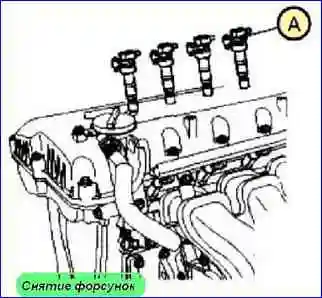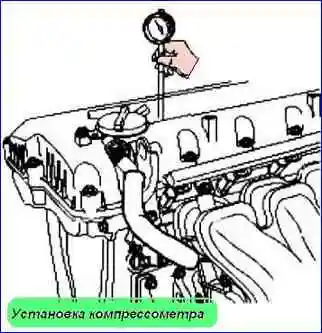If there is a loss of power, increased fuel consumption or increased oil consumption, it is necessary to check the compression in the engine cylinders
1. Warm up and stop the engine to normal operating temperature

- 2. Disconnect the ignition coil (B) and injector (A) connectors.
- 3. Remove injectors (A)

- 4. Remove the spark plugs. Using a 16 mm special wrench, remove 4 spark plugs.
- 5. Check compression in each cylinder.

- - install the compression gauge into the spark plug hole.
- - open the throttle valve fully.
- - while cranking the crankshaft and starting the engine, measure the compression.
Make sure the battery is fully charged to provide 200 rpm.
The compression check must be done in as little time as possible.
- - Repeat the above operations for each cylinder.
- - Standard compression value: 1283 kPa. Minimum permissible value: 1135 kPa. The difference between the compression of each cylinder: no more than 100 kPa.
- - If there is insufficient pressure in one or more cylinders, pour a small amount of engine oil through the spark plug hole into the cylinder and repeat steps 1 to 3.
- - If the compression has increased, it means that the compression rings are damaged or the piston has increased wear.
- - If the compression pressure has not changed, the valve seats are likely damaged or the valve is not seated properly.
A possible cause may also be damage to the cylinder head gasket.
Turn in the spark plugs.
Install the ignition coils.
Connect the connector of the injector and ignition coil.





